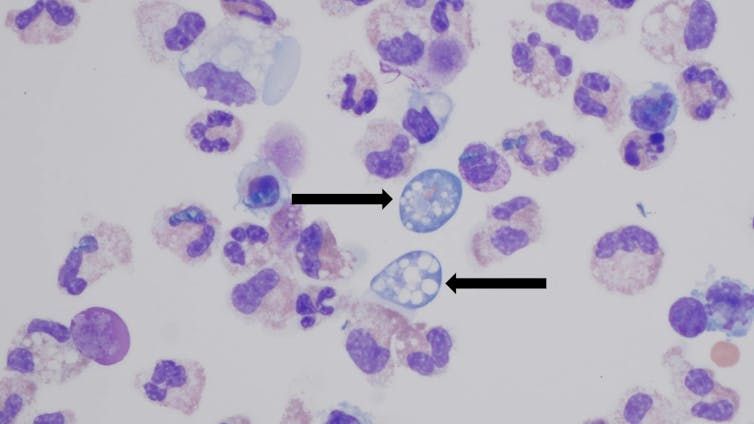On hot summer days, hitting the beach is a great way to have fun and cool off. But if you’re not near the salty ocean, you might opt for swimming in a freshwater stream, river, lake or pool.
These freshwater swimming holes are great, but they come with a hidden danger. While it’s very rare, it can be deadly – a brain infection by a microbe widely known as the “brain-eating amoeba”.
What is the brain-eating amoeba?
The pathogen in question is called Naegleria fowleri. The “brain-eating” part makes it sound like an unlikely creature of science fiction, but sadly it’s a real – and potentially deadly – organism.
The amoeba was first discovered by medical scientists in South Australia in the 1960s following several mysterious deaths from an unusual form of meningitis in the 1950s.
It can cause an often incurable infection called primary amoebic meningoencephalitis. This disease has caused hundreds of fatal infections across several countries. Young males are most commonly affected, and the average age of infections is 12 years old.
N. fowleri is a microscopic single-celled organism. It is commonly found in freshwaters and soilthriving in warmer water temperatures ranging from 25°C to 40°C.
It doesn’t survive in saltwater or freshwater correctly disinfected with chlorine. This includes chlorinated municipal water supplies which are disinfected and thoroughly tested to ensure all pathogens, including N. fowlerican’t survive. This water is safe for all uses including bathing and showering.
Infections are very rare. But they are deadly serious, as only a handful of people have survived the infection.
The United States has recorded more cases than any other country, not least due to the fact they keep stringent records and regularly provide reports on these types of infections. According to the US Centers for Disease Control, of the 164 reported cases (1962 to 2023) in the US, only four people have survived. This is a fatality rate of 97.5%.
Australia has recorded 22 cases up until 2018, according to a global review. Four confirmed cases have been reported from Queensland since 2000.

How does the amoeba get into the brain?
This disease has a highly unusual infection pathway. You can’t be infected by drinking contaminated water. It can only infect a person’s brain through water entering their nose and nasal passages. This allows the amoeba to pass through nasal tissue and infect the brain and central nervous system.
People have been fatally infected by rinsing their nasal passages with water that contained the amoeba. Such nasal rinses should only use suitably sterilised water.
Some of the early symptoms of the infection are headaches, nausea, vomiting, fever and neck stiffness. It may take several days for the infection to develop after exposure to the amoeba.
If someone suffers these symptoms after being exposed to potentially contaminated waters, urgent medical attention is needed. Although the survival rate is less than 5%, there are rare cases where prompt medical attention helped an infected person survive.
Although the amoeba generally survives in waters in warm climates, it has infected people in heated waters in cooler environments. In 1978, a girl was fatally infected after swimming in the geothermal baths built by Romans in the English city of Bath. The baths have been closed for swimmers ever since.
In Australia, Lake Liddell in the Hunter Valley, New South Wales, was closed to the public in 2016 after detection of the amoeba. The waters of the lake were artificially warm as they were used for cooling a coal-fired power station that’s now closed.
What can I do to avoid the amoeba?
Firstly, N. fowleri can’t survive in ocean saltwater. But it can live in warm freshwaters, rivers, hot springs, streams, pools or lakes.
If you are in any doubt, it is safest to assume the amoeba is present in these water sources. You can still swim, but don’t put your head under water. Take care to prevent any water entering your nose.
This might be difficult for children who often engage in games, lots of splashing, and jumping or diving into the water. It may be impossible for them to do this without risking water entering their noses.
If you are considering swimming in a freshwater swimming pool, make sure the pool is well maintained and disinfected with the correct amount of chlorine. This prevents the amoeba’s survival, and makes a well-maintained, disinfected pool safe to swim. (A clean, filtered and properly chlorinated swimming pool also protects swimmers from other water-borne pathogens.)
The chances of acquiring this disease are remote. But if infected, it’s likely to be fatal.
Remember that children under your care are particularly vulnerable. If possible, choose to swim in well-maintained and chlorinated swimming pools. In freshwater sources, just don’t put your head under the water.![]()
Ian A. WrightAssociate Professor in Environmental Science, Western Sydney University
This article is republished from The Conversation under a Creative Commons license. Read the original article.




